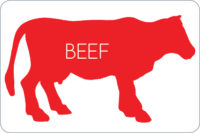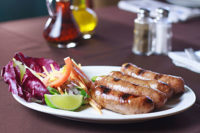BEEF
Holding Steady
By Megan Pellegrini, contributing writer
The inherent versatility of the beef category is helping it ride out rising feed costs, and also inspiring processors to develop creative ways to reach out to consumers.
If the $71 billion beef industry is feeling the heat from rising fuel and animal feed costs, it’s not showing it — to consumers anyway.
Due to ever-increasing feed costs, cow-calf operators now spend about $245 per cow, compared to $209 in 2000, reports the American Angus Association. That extra $35 in expense has lead producers to review optimizing cow size and milk genetics, amongst other factors.
In addition, processors have developed creative strategies to keep consumers — and their retail and foodservice clients — interested in beef despite higher costs, while they search for other ways to remain profitable. As a result, shoppers can peruse a wide spectrum of heavily promoted beef products today, from Wagyu-Angus ground beef to value cuts of boneless-style country ribs.
Indeed, Americans consumed 28 billion pounds of beef in 2006, a slight increase from 2005, according to the U.S. Department of Agriculture’s (USDA) Economic Research Service, despite tight supplies and higher prices.
“Beef demand is remarkably strong,” says Randy Irion, director of retail marketing for the Denver-based National Cattlemen’s Beef Association (NCBA), which contracts to manage retail programs for The Beef Checkoff Program, noting that the fresh beef category grew by 0.5 percent as total meat sales increased 0.3 percent (for the 52-week period ending on July 1, 2007). “While total meat pound sales decreased 1.3 percent, beef had a significantly smaller supply shrink at 0.4 percent during this time period.”
| Annual Beef Forecasts | |||||
| 2004 | 2005 | 2006 | 2007 | 2008 | |
| Production (millions lbs.) | 24,548 | 24,683 | 26,153 | 26,070 | 26,315 |
| Per capita disappearance* (retail lb.) | 66.0 | 65.4 | 65.7 | 65.0 | 64.4 |
| Beef and veal exports (millions lbs.) | 460 | 698 | 1,153 | 1,334 | 1,580 |
| Beef and veal imports (millions lbs.) | 3,679 | 3,599 | 3,085 | 3,200 | 3,300 |
| —Forecasts are in bold. *Per capita meat disappearance data are calculated using the Resident Population Plus Armed Forces Overseas series from the Census Bureau of the Department of Commerce. Source: World Agricultural Supply and Demand Estimates and Supporting Materials. For further information, contact: Mildred Haley, (202) 694-5176, mhaley@ers.usda.gov | |||||
Over the course of the last year, beef and total meat supply has decreased and prices have risen. Beef’s dollar sales, on a diminished supply, actually increased by 0.5 percent while total meat sales increased by just 0.3 percent, reported FreshLook Marketing Group. This is a strong indication of strong beef demand despite a slightly diminished supply.
The rising cost of beef, averaging $3.97 per pound in 2006, has left its mark in the meat case by changing consumers’ normal pattern of demand, says Pat Huebner, senior vice president of business development and research and development, Swift & Co., based in Greeley, Colo.
“We are seeing more end cuts offered as specials during the summer months which has traditionally been the steak domain,” he says, impacting processors who buy end cuts during the off season. “We are seeing changes in the typical buying cycles, so that burgers, for example, are popular in the winter instead of the summer.”
The most recent analysis available for natural and organic sales is through the first calendar quarter of 2007. Natural and organic beef products continue to remain strong year round, as they posted gains of 25.9 percent in dollar sales and 31.8 percent in volume sales for the 52 weeks ending on
April 1, says Irion. “They are niche items, but their sales growth is greater than the total category, showing continued interest from consumers,” he says.
There is also greater availability today of leaner beef cuts, and the 29 lean cuts available are growing at a significant rate. FreshLook Marketing data reveals that leaner ground beef items have shown sharper growth rates than the traditional volume leader in ground beef, which is labeled 70 to 77 percent lean.
From plate to retail
Health-conscious consumers aren’t willing to give up taste for well-being, though. If a familiar item has a strong ethnic flavor or twist, they will be even more likely to try it. Culinary professionals from Martha Stewart to Paula Deen are instructing consumers on how to prepare foods today with “chef’s fingerprints, which ties in with the bold, ethnic flavors they want today,” says Lauren Ascroft, manager of marketing services for Quantum Foods, based in Bolingbrook, Ill.
According to Ascroft, beef processors are also seeing the “premiumization” of commodity items in foodservice, such as premium-price Angus burgers at Hardee’s, Carl’s Jr. and Back Yard Burgers. Some restaurants are even using protein as a premium topper, with burgers accenting meatloaf or burgers with steak toppings.
“We’re seeing this in foodservice, but it will probably make its way into retail, as consumers look to buy restaurant-quality foods and re-create entrees at home,” says Ascroft. Consumers certainly recognize the Angus brand as a superior product, and gourmet, upscale burgers dominate casual restaurant menus today.
Bill McClellan, senior vice president and general manager of foodservice sales channel for Swift, notes that as gas prices rise, consumers are more likely to trade dining out at a casual restaurant to a quick casual or quick serve restaurant.
“People still want to eat out, despite higher gas prices, but they lower their costs by going to a quick-casual place like Baja Fresh or quick service restaurants such as Wendy’s and McDonald’s,” he says.
Prime and dry-aged beef is also making its way from restaurants and butcher shops to retail meat cases, says Irion. “Offering these items is one way retailers can distinguish their operations from others down the street and offer a point of differentiation other than price points,” says Irion.
Value-added Flat Iron steaks, introduced about five years ago, continue to be a strong meat for the casual restaurant business, while retail and foodservice partners are also using pre-sliced and tenderized meats to reduce labor expenses. “They appreciate being able to just pull it out of the package and have it look like it was prepared in the back of the house,” says McClellan.
In today’s dynamic supermarket environment, customers are in need of more product labels that provide information such as instructions on various cooking methods (such as grilling, braising and roasting), recipes and nutritional information including calories, fat and health benefits. “Industry research shows that one-third of customers are more interested in shopping at stores that offer on-pack nutrition labels,” says Irion.
Portion control packaging will also continue to be a hot trend for women and children, says Ascroft, with 100 calorie-type packaging making its way into beef.




